Context
A notable conceptual innovation of Gilles Deleuze and Felix Guattari (D/G) is the binarism of deterritorialization and reterritorialization. Originally developed by Guattari in the context of Lacanian psychoanalysis,1 it takes on a life of its own in their collaborative works from Anti-Oedipus (1972) to What is Philosophy? (1991), where in its physical, psychological, and social connotations it signifies a transformative impulse or dynamics and their respective counterparts or limits. More literally, de- and reterritorialization describe processes of leaving and returning to territories – as in animal migration and territorial behavior2 – where deterritorialization is an essentially globalizing vector that leads from any given territory straight to the whole of the Earth. In their analysis of capitalism, for example, deterritorialization denotes the ways capitalism shatters feudal society, “sets free” the worker from his/her land etc., but also points to the fact that it ultimately establishes a “world-wide capitalist machine,” integrating centers and peripheries.3 And it is indeed the Earth as a planet that functions both as vanishing point and subject of all deterritorializations: “It merges with the movement of those who leave their territory en masse, with crayfish that set off walking in file at the bottom of the water, with pilgrims or knights who ride a celestial line of flight.”4 While this makes D/G preeminent geophilosophers, the deterritorializations they focus on typically take place on the Earth’s surface and unfold on historical timescales.
But times have changed. The 20th century already feels like prehistory. On the one hand, “French theory” has waned and given way to strands of thought like New Materialism (Bennett, Barad), Speculative Realism (Brassier, Meillassoux), and Xenofeminism (Laboria Cubonics). On the other hand, our geological age, the Anthropocene,5 leaves us wanting a conceptual manual that would allow us to come to grips with processes that drive right into the crust of the Earth and shortcut immediately with geologic timescales – for these are the processes the planet, and our lives on it, are all about today.
As a starting point for developing such a manual, I propose here the new terminology of defossilization and refossilization.
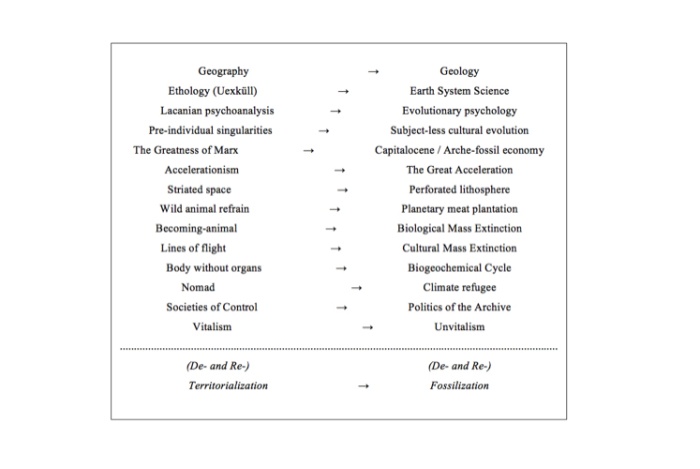
Il. 1: Od Deleuze’a i Guattariego do antropocenu
De- and refossilization in their respective connotations as mapped out below capture with some precision what is happening to the planet in the early Anthropocene. Beyond the scope of the present paper, the terminological shift from territorialization to fossilization signals a sea change in the intellectual climate that comes with a whole series of new conceptual priorities and intuitions (Fig. 1).6 I’ll just mention two here:
First, while D/G favor deterritorialization over reterritorialization and seem not to be able to get enough of it – “one can never go far enough in the direction of deterritorialization”7 – we realize that there is nothing particularly great about excessive rates of change and extreme cultural dynamism represented, for example, by the Great Acceleration of the Anthropocene (1950ff.).8 We’ve become agnostics about becoming. The “new earth” D/G believe deterritorialization brings forth9 is one that sets in motion masses of climate refugees and creates mass extinctions.
Second, where D/G fight a lifelong battle of dissolving the human subject into a-subjective machinic assemblages and pre-individual events and singularities,10 we realize that the overall dynamics of cultural evolution are always already a-subjective and pre-individual – the onset of the Anthropocene is no more intentional or conscious an event than e.g. the Great Oxygenation or the multiple Snowball-Earth events that occurred on early Earth.11 But this, too, is nothing to applaud. It merely indicates the continued lack of a planetary political constitution.
But let us now see how the de- and refossilization play out (Fig. 4).
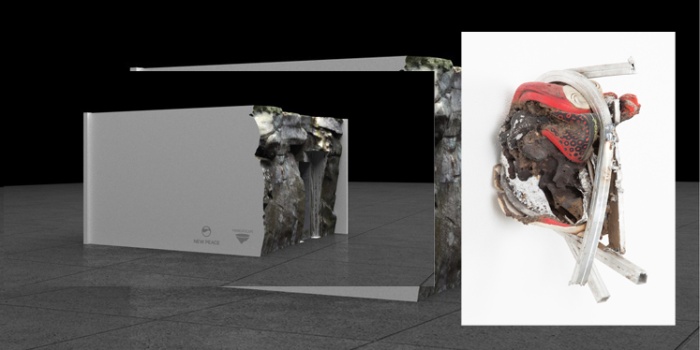
Il. 2. Timur Si-Qin, Sala modlitw NOWY POKÓJ, 2016. Praca prezentowana w sekcji „Statements” targów Art Basel, 2016; źródło. Il. 3. Antoine Renard, Nowa równowaga, 2016. Praca prezentowana na wystawie solowej Black Dance, Valentin, Paryż; źródło.
A New Manual
1. (Un-)Doing Strata
The Anthropocene sets in motion unprecedented flows of matter that is scraped and excavated from the Earth’s lithosphere and streams into the energy and manufacturing industries. These anthropogenic flows vastly exceed those of materials moved around Earth through natural processes, making humans the greatest geomorphic agent on the planet.12 While mining coal and other raw materials has a 6000-year history, it does not escalate before the 1800s; oil extraction only takes off in the 20th century. Some 70 billion tons of materials (fossil fuels, metal ores, non-metallic minerals, biomass) are currently being pulled from the ground every year (up from 24 billion 40 years ago).13 Five of the top ten companies on the Fortune Global 500 list – employing 2.3 million people – are fossil excavation enterprises.14
Their efforts and machinations, among others, constitute defossilization 1: undoing the geologic fabric of the Earth by undoing its sedimentations. As coal and oil are the petrified remains of prehistoric maritime organisms and plants, the capitalist economy is literally based on burning fossils, thereby unwillingly recreating a prehistoric climate.15
Defossilization 1 shortcuts the present with the deep time of the Earth. Given the panoramas of deep time are products of scientific metaphysics – they have no reality inside the empirical world of present-day Earth –16 defossilization 1 activates the metaphysical and showcases our deep entanglement with it – we even use the same materials (sediments) to investigate the metaphysical world of prehistory and to fuel the world economy. As the Meillassouxian notion of the “arche-fossil” captures both aspects at once, one may define today’s capitalism with greater precision as a system of burning arche-fossils – a metaphysical explosion inside the physical world.17 If the Capitalocene concept is to have any distinctiveness, this is what it has to be about.18
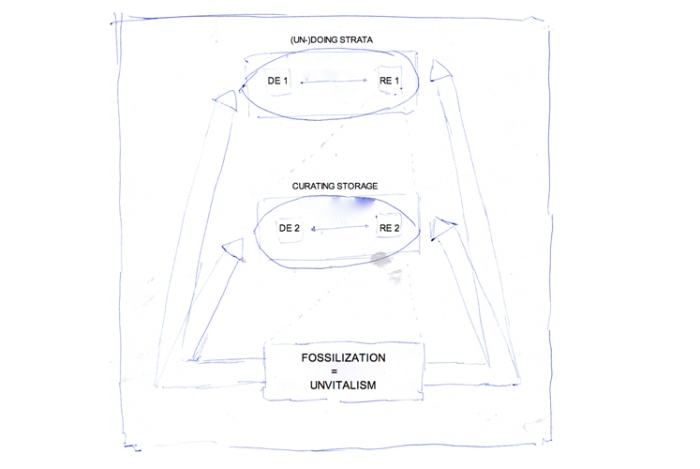
Il. 4. Instrukcja
By the same token, defossilization 1 activates the Earth’s deep time where the fuels are produced as the canvas on which humans’ history and their early migrations around the globe unfold, marking the total arbitrariness of which portion of a natural resource today comes to lie under whose ground or which neo-colonial enterprise manages to put its hand on it: defossilization 1 calls for the world’s natural resources to be held in trust, for the world population, by a new UN institution (inside UNEP), and for a total equalization of its current vastly unequal material footprint.19
The excavated materials don’t disappear, they stick around. Where burned, they are deposited in the atmosphere (climate change). Where otherwise processed, they become the material infrastructure of the planetary Technosphere – buildings, machinery, transportation infrastructure, etc. today worth 30 teratons of material.20 But production produces pollution and waste, deposits accrue in landfills, spill into ground water and bodies, commodities become trash, buildings are being dismantled, new edifices built on top of ruins, cities abandoned, overgrown, sinking into the ground... Part of the Anthropocene diagnosis is that through such processes, a new geologic stratum is forming as we speak – the Anthropocene stratum that with its own technofossil stratigraphy significantly differs from that of the underlying Holocene stratum, and frankly of any other stratum the Earth has seen before.21 This is denoted by refossilization 1.
Refossilization 1 grounds the equation “pollution/waste = condition of possibility for historiography” (see below). It also turns our present into a virtual “incavation”-site of future excavations that will never take place, and points to a deep future in which the Anthropocene stratum will ultimately be completed: to an Earth beyond and without hominins.22
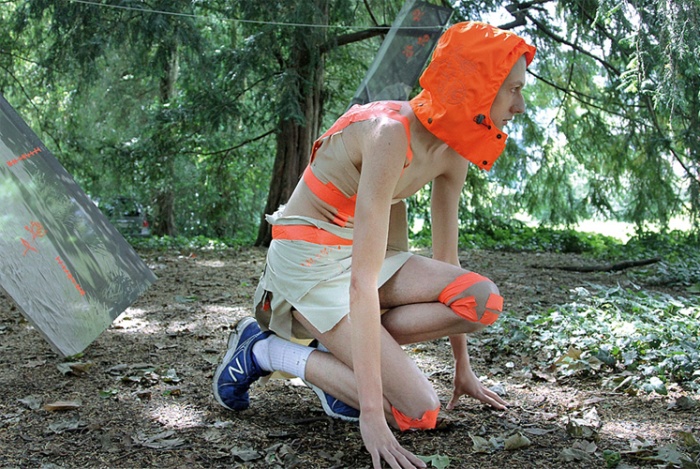
Il. 6. Agatha Valkyrie Ice (Dorota Gawęda & Eglė Kulbokaitė), Perma-permaśmierć, 2016. Performans prezentowany na targach LISTE, kurator Eva Birkenstock, Bazylea, 2016; źródło.
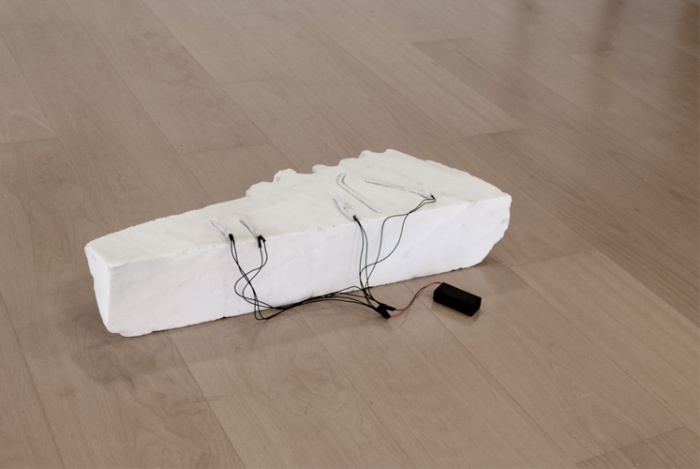
Il. 5. Olga Balema, Bez tytułu, 2018. Praca prezentowana na wystawie grupowej Oh that I had a thousand tongues, kurator Nikola Dietrich, Tinos Quarry Platform, Tinos, 2018; źródło.
2. Curating Storage
Zooming in on refossilization 1, one may inquire as to the “curatorial” vectors that shape the Anthropocene stratum or more generally the various stored deposits – of variable, not necessarily geologic durability – of the current age, and thereby uncover another dimension of our terminology.
Considering a stratum/storage in the making, defossilization 2 signifies that which is no longer being part of it. A species that is driven to extinction is defossilized as it stops producing fossils, leaves no trace in the stratum going forward. The biosphere has endured five mass extinction events since the Cambrian Explosion: five big defossilization 2 events so far. The early Anthropocene is but once more, and just as unintentionally, a heyday of defossilization 2 – the Anthropocene stratum will ultimately be cleared of the vast majority of Holocene biota.23 But the early Anthropocene constitutes not only a biological, but also a cultural Mass extinction event, as colonial and capitalist globalization drives pre-global, pre-modern, pre-digital technologies, mindsets, ways of life and of doing society rapidly into extinction. The Earth is being cleared from the diversity cultural evolution has produced in the 75,000 years during which the species had “lost itself” in the respective continents and territories of the planet – this pre-global cultural diversity is disappearing from the archeological and historical record of the present. As globalization only happens once, this is a one-of-a kind wave of cultural defossilization. Most pre-modern cultural content will shortly stop leaving traces.
Contra D/G, there is nothing to love about these “becomings.” Defossilization 2 instead calls for an – essentially humanitarian, “state of emergency”-type – management of this hyper-fast and extremely traumatic process on behalf of the generational living against the purely survivalist machinations of transgenerational cultural evolution.24
On a side note, defossilization 2 also carries utopian overtones. If the production of geologic – as well as archaeological and historical – deposits is essentially an act of pollution (cf. refossilization 1), then the presence of such deposits on Earth indicates that the biosphere’s workings themselves have never been "sustainable."25 A sustainable biosphere simply would have left behind no fossil fuels to burn and no geologic past to uncover. Based on this circumstance, and toying with D/G’s notion of “absolute deterritorialization,”26 one can envision a concept of absolute defossilization where in the register of defossilization 1, absolute defossilization signifies a complete excavation of all ever-usable raw materials from the lithosphere, while in the register of defossilization 2, it signifies the utopian – and entirely “unnatural” – idea of a 100% sustainable world economy, a Kenneth Boulding-type “spaceman economy” that features only closed circles of material flow,27 a planetary regime of eternal recycling that stops producing ANY deposits. Absolute defossilization in this sense converges towards an Anthropocene without a stratum.
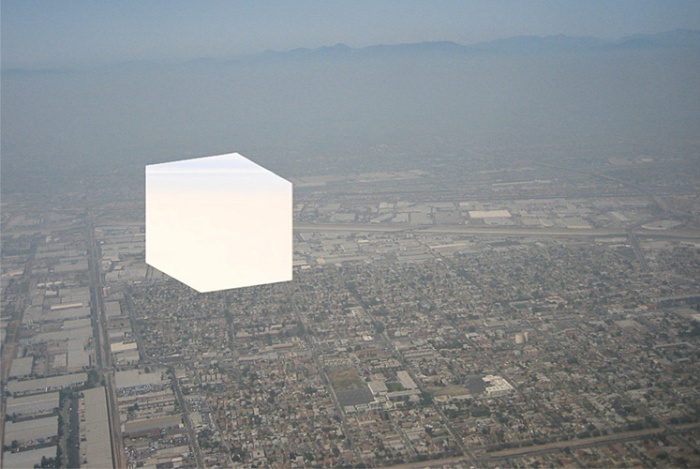
Il. 8. Amy Balkin, Smog publiczny, od 2004. Projekt artystyczny w toku, zob.: tomorrowmorning.net/publicsmog; źródło.

Il. 7. Jonathan Kemp, Ryan Jordan, klatka z filmu Warsztat dekrystalizacji, 2011. Warsztat w nohup, Londyn, 2011; źródło.
Biological and cultural mass extinction is only one side of the coin, however. While biological and cultural content is indeed being defossilized in unprecedented quantities and speeds, the early Anthropocene at the same time witnesses an explosion of storage capabilities. While the invention of writing and Gutenberg’s revolution, on their part, already added many orders of magnitude to the species’ information storage capacities, the advent of digital storage media brought boosted them into entirely novel dimensions.28 The regular functioning of Internet services, but also of Big-data applications like financial markets, autonomous transportation, genetics research, intelligence agencies etc. are unthinkable without this. These vectors and effects of digital storage are here called Refossilization 2: more and more data are being fossilized into an interconnected techno-mineral system of planetary scale Internet of Things (IoT), while its HDDs, SDDs, and other hardware components become the new trace fossils of the Anthropocene stratum.
Refossilization 2 accentuates the hitherto unsolved task of long-term data transfer and compatibility throughout rapidly evolving systems to prevent routine defossilization 2 (data loss). More importantly, against the backdrop of a still arbitrary playing field of corporate and state agents of digital storage today, and of largely unhelpful liberal or libertarian ideologies among the Internet activism community, refossilization 2 carries the seed of a new – no longer liberal, but geologico-socialist – Politics of the Archive.
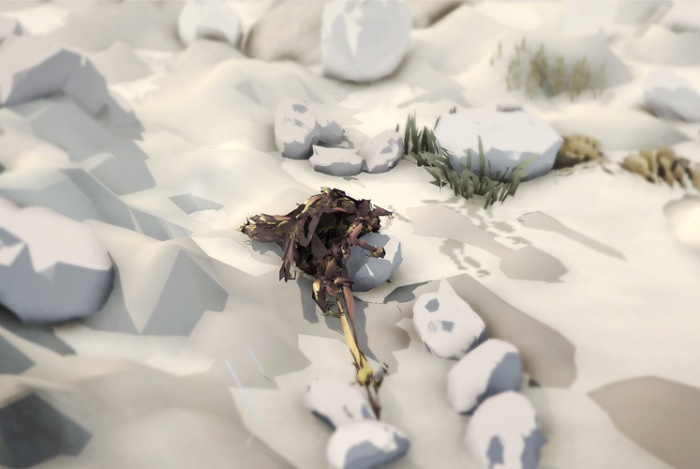
Il. 9. Ian Cheng, Coś, co myśli o tobie, 2015. Wideo prezentowane na żywo na stronie vdrome.org w VIII 2015; źródło: iancheng.com.
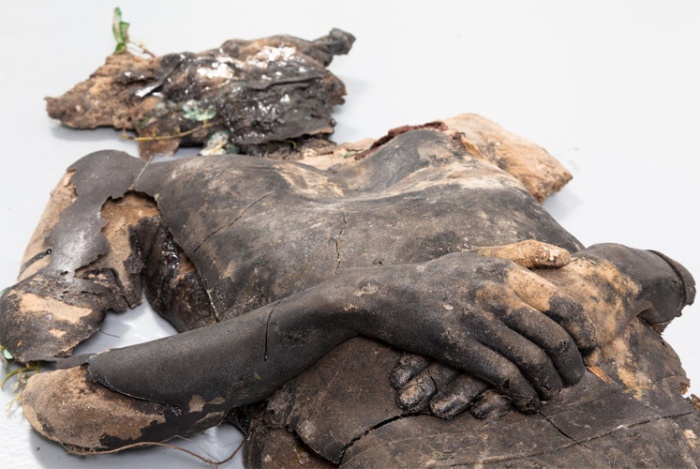
Il. 10. Antoine Renard, ShauN, 2016. Praca prezentowana na wystawie indywidualnej Black Dance, Valentin, Paryż; zdjęcie: Sylvie Chan-Liat; źródło.
3. Unvitalism
Zooming in on refossilization 2, one realizes it is part of an overall process that is of great significance for the future history of thought on Earth – perhaps its single most important parameter. A geological concept, the Anthropocene directs attention to the unliving components of the Earth – the abiotic geosphere.29 The Earth’s biogeochemical cycles – veritable metabolisms in stone – manifest the energetic and material interaction and interpenetration of biosphere and geosphere and thus the continuous and crucial agency of the unliving on a living planet.
From this angle, the agency of the unliving in the Technosphere becomes a site of interest as well. For example, following Marx’s Fragment on Machines, D/G are aware that the unliving matter of fixed capital (machinery) in itself has become a source of economic productivity in industrial times30 – however, as it is knowledge and science that produces advanced machinery,31 and as knowledge and science for the most part have been embodied and pursued in the wetware of living human cortices, biology remains the ultimate source of cognitive surplus here.
Digital technologies mark the point where the productive agency of the unliving ceases to be purely derivative or manual but becomes cognitive in its own right. Unliving agents – computers, big data analyses, self-learning algorithms, neuronal networks, AI’s – today embody the highest “vitality” of spirit.32 The Earth’s crust has started to think in the Anthropocene. So, this is in fact the unvitalism of spirit: the minerals of computer hardware that replace the liquids of the brain (as if in a petrifaction of thought), the thinking and acting fossils of processors and hard drives in their planetary IoT become the core agents and drivers of the historical process.
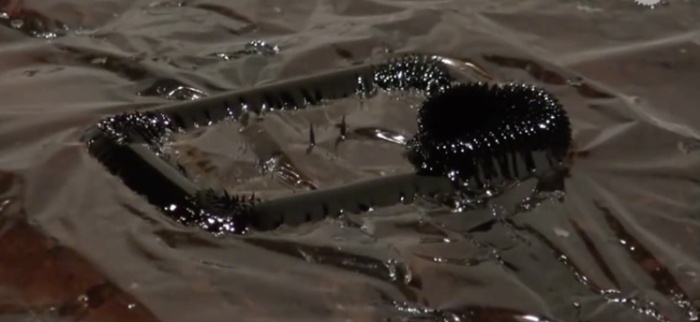
Il. 12. Sam Lewitt, klatka z pracy Płynne zatrudnienie, 2012. Praca prezentowana na Whitney Biennial 2012, kuratorzy Elisabeth Sussman i Jay Sanders, Whitney Museum, Nowy Jork, 2012; źródło.
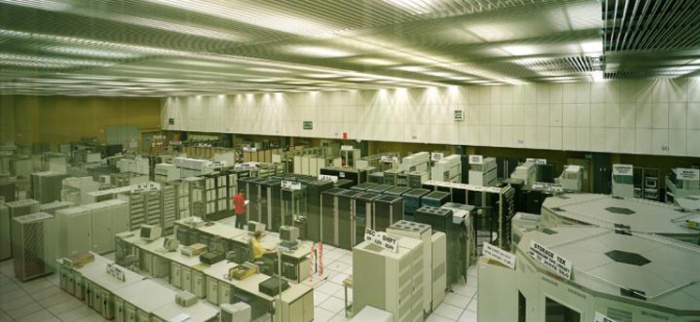
Il. 11. Armin Linke, Centrum sterowania CERN, 2000. Praca prezentowana na wystawie GLOBALE: Armin Linke. The Appearance of That Which Cannot be Seen, kurator Philipp Ziegler, ZKM, Karlsruhe, 2016; źródło.
The plain term, fossilization, describes this excess of unliving agency. Incomparably more physically impactful than even the Earth’s volcanism or plate tectonics, it becomes the driving force behind the other de- and refossilization processes as it directly impacts defossilization 1 (the fossil excavation enterprises are among the most technologically advanced) and obviously refossilization 2, thereby also heavily factoring in to refossilization 1, and defossilization 2. (It might even be the prerequisite for large-scale ecological governance and sustainability monitoring in the biosphere, should it one day become real.)33
Fossilization marks the end of the but temporary pact of philosophy with biological matter and poses the question of the future of the biological individual – not to speak of the biological worker – in the Anthropocene Technosphere to come.
Arts
Contemporary art has demonstrated sensitivity towards our present de- and refossilizations.
In the 2010s, artists – often, but not exclusively from the spectrum of Post-Internet Art – produce artificial geoformations as environments (Fig. 2), experiment with anthropogenic sedimentation processes, anticipate the technofossilization of contemporary everyday objects (Fig. 3), and reevaluate the geomorphological valence of ceramics.34 They show performances with hyper-technoid early hominins (Fig. 6), put down mummies on the gallery floor (Fig. 10), strip organisms from everything but their fossilizable skeleton, and produce 3D prints of archaeological remnants.35 They anticipate the post-cultural mass extinction planetary Technosphere (Fig. 13). They reference the geological nature and temporality of the crystals and metals inside our communications technologies36 and wire stone (Fig. 5), while otherwise “unearthing” those materials from the devices, freeing them up for new geomorphological trials of planetary recycling (Fig. 7).37 They buy (and thus pull from the market) certificates for emissions from burning arche-fossils (Fig. 8). They produce processor-based habitats as “live” animations (Fig. 9), document the unliving machineries of scientific thought (Fig. 11) and stage uncanny spectacles of unliving ferrofluid agency (Fig. 12). Curators and curatorial collectives initiate exhibitions 2000 meters below the Earth’s surface and conduct ephemeral shows on the site of eroded geological formations.38
All this is light years ahead of all de- and reterritorializations. Contemporary art rehearses the vectors of fossilization before philosophy does. In concert with Anthropocene discourse, it labors to create the cognitive resources we need to arrive at the new manual – the new interface to our age.

Il. 13. Anne Imhof, Angst III, 2016. Performans prezentowany na La Biennale de Montréal, kurator Philippe Pirotte, Montreal, 2016; zdjęcie: Jonas Leihener, (c) BNLMTL; źródło.
BIO
Daniel Falb is a philosopher and poet based in Berlin. He holds a PhD in philosophy and has published three volumes of poetry with publisher Kookbooks. Falb’s research focuses on geophilosophy, art theory and poetology. Recent publications include Anthropozän. Dichtung in der Gegenwartsgeologie [Anthropocene. Poetry in the Geology of the Present] (Verlagshaus Berlin 2015) and Geospekulationen. Metaphysik für die Erde im Anthropozän [Geospeculations. Metaphysics for the Earth in the Anthropocene] (Merve 2019). His new volume of poetry, Orchidee und Technofossil [Orchid and Technofossil] will be out in spring 2019. https://independent.academia.edu/DanielFalb
*Cover photo: Ian Cheng, Something Thinking of You (2015).
[1] Félix Guattari and Gilles Deleuze, Psychoanalysis and Transversality: Texts and Interviews 1955–1971, trans. Ames Hodges (South Pasadena, CA: Semiotext(e), 2015); cf. Adrian Parr, ed., The Deleuze Dictionary, Rev. ed (Edinburgh: Edinburgh Univ. Press, 2010), 69–72. See Eugene W. Holland, “Deterritorializing ‘Deterritorialization’: From the ‘Anti-Oedipus’ to ‘A Thousand Plateaus,’” SubStance 20, no. 3 (1991): 55–65 for a general terminological outline.
[2] See Gilles Deleuze and Félix Guattari, A Thousand Plateaus: Capitalism and Schizophrenia, 12. print (Minneapolis, Minn.: Univ. of Minnesota Press, 2007), 310–50; Gilles Deleuze and Félix Guattari, What Is Philosophy? (New York: Columbia University Press, 1994), 67f.
[3] Gilles Deleuze and Félix Guattari, Anti-Oedipus: Capitalism and Schizophrenia (Minneapolis: Univ. of Minnesota Press, 1994), 231.
[4] Deleuze and Guattari, What Is Philosophy?, 85.
[5] Will Steffen, Paul J. Crutzen, and John R. McNeill, “The Anthropocene: Are Humans Now Overwhelming the Great Forces of Nature,” AMBIO: A Journal of the Human Environment 36, no. 8 (December 2007): 614–21; W. Steffen et al., “The Anthropocene: Conceptual and Historical Perspectives,” Philosophical Transactions of the Royal Society A: Mathematical, Physical and Engineering Sciences 369, no. 1938 (March 13, 2011): 842–67.
[6] This is not to say that it is impossible to connect selective readings of D/G to aspects of the Anthropocene condition (Cf. Arun Saldanha and Hannah Stark, “A New Earth: Deleuze and Guattari in the Anthropocene,” Deleuze Studies 10, no. 4 (November 2016): 427–39) – especially as D/G are indeed pioneers of a geophilosophical mindset. Such readings, however, can not stand in for the required new manual and do not obviate its associated conceptual innovations.
[7] Deleuze and Guattari, Anti-Oedipus, 321; cf. ibid. 239ff. See also Holland, “Deterritorializing ‘Deterritorialization,’” 58.
[8] Will Steffen et al., “The Trajectory of the Anthropocene: The Great Acceleration,” The Anthropocene Review 2, no. 1 (April 1, 2015): 81–98. Note the irony that Anti-Oedipus was published in the same year as Limits to growth (Donella H. Meadows, Club of Rome, and Potomac Associates, eds., The Limits to Growth: A Report for the Club of Rome’s Project on the Predicament of Mankind [New York: Universe Books, 1972]).
[9] Deleuze and Guattari, Anti-Oedipus, 321, 382; Deleuze and Guattari, What Is Philosophy?, 88, 99.
[10] Deleuze and Guattari, Anti-Oedipus, 1; Gilles Deleuze and Anne Boyman, Pure Immanence: Essays on a Life, 2. print (Cambridge, Mass: Distributed by the MIT Press, 2002), 25ff.
[11] Cf. Peter Douglas Ward and Donald Brownlee, The Life and Death of Planet Earth: How Science Can Predict the Ultimate Fate of Our World (Piatkus, 2007).
[12] Roger LeB. Hooke, “On the History of Humans as Geomorphic Agents,” Geology 28, no. 9 (2000): 843–846, 843. Cf. J. Zalasiewicz et al., “Stratigraphy of the Anthropocene,” Philosophical Transactions of the Royal Society A: Mathematical, Physical and Engineering Sciences 369, no. 1938 (March 13, 2011): 1039.
[13] United Nations Environment Program, “Global Material Flows and Resource Productivity. An Assessment Study of the UNEP International Resource Panel” (Paris, 2016), 33. Reference year is 2010.
[14] See fortune.com/global500
[15] “Temperature is predicted to rise by 1.1 °C to 6.4 °C by the end of this century, leading to global temperatures not encountered since the Tertiary” – more than 2.58 million years ago. Jan Zalasiewicz et al., “Are We Now Living in the Anthropocene,” GSA Today 18, no. 2 (2008): 5.
[16] See Daniel Falb, Geospekulationen. Metaphysik für die Erde im Anthropozän (Berlin: Merve Verlag, 2019), Chap. I.1, I.3.
[17] Quentin Meillassoux, After Finitude: An Essay on the Necessity of Contingency, trans. Ray Brassier, Reprinted (London: Bloomsbury Acad, 2012), 10.
[18] Jason W. Moore, ed., Anthropocene or Capitalocene? Nature, History, and the Crisis of Capitalism, Kairos (Oakland, CA: PM Press, 2016).
[19] UNEP, “Global Material Flows and Resource Productivity. An Assessment Study of the UNEP International Resource Panel,” 17.
[20] Jan Zalasiewicz et al., “Scale and Diversity of the Physical Technosphere: A Geological Perspective,” The Anthropocene Review 4, no. 1 (April 2017): 9–22. Cf. P. K. Haff, “Technology as a Geological Phenomenon: Implications for Human Well-Being,” Geological Society, London, Special Publications 395, no. 1 (2014): 301–9.
[21] Zalasiewicz et al., “Stratigraphy of the Anthropocene”; Jan Zalasiewicz et al., “The Technofossil Record of Humans,” The Anthropocene Review 1, no. 1 (April 2014): 34–43.
[22] Jan Zalasiewicz, The Earth after Us: What Legacy Will Humans Leave in the Rocks? (Oxford: Oxford University Press, 2009).
[23] Elizabeth Kolbert, The Sixth Extinction: An Unnatural History, First edition (New York: Henry Holt and Company, 2014).
[24] See Falb, Geospekulationen. Metaphysik für die Erde im Anthropozän, Chap. II.2.
[25] Josef H. Reichholf, Stabile Ungleichgewichte: die Ökologie der Zukunft, Orig.-Ausg., 1. Aufl. 2. Druck, Edition Unseld 5 (Frankfurt am Main: Suhrkamp, 2009); Peter Ward, The Medea Hypothesis: Is Life on Earth Ultimately Self-Destructive? (Princeton University Press, 2009). The first substantial use of the sustainability concept is here: World Commission on Environment and Development, ed., Our Common Future, Oxford Paperbacks (Oxford ; New York: Oxford University Press, 1987).
[26] Cf. Deleuze and Guattari, What Is Philosophy?, 88.
[27] Kenneth Boulding, “The Economics of the Coming Spaceship Earth,” in Environmental Quality in a Growing Economy, ed. Jarrett (Baltimore, MD: Resources for the Future/Johns Hopkins University Press, 1966), 3–14.
[28] R. Alexander Bentley and Michael J. O’Brien, “Cultural Evolutionary Tipping Points in the Storage and Transmission of Information,” Frontiers in Psychology 3 (2012): 1–14.
[29] It encompasses lithosphere, atmosphere, hydrosphere, and cryosphre.
[30] Deleuze and Guattari, Anti-Oedipus, 232.
[31] Deleuze and Guattari, 234.
[32] Cf. Benjamin Bratton, “The City Wears Us. Notes on the Scope of Distributed Sensing and Sensation,” Glass-Bead, Site 1: Logic Gate, the Politics of the Artificial Mind (2017), glass-bead.org/article/city-wears-us-notes-scope-distributed-sensing-sensation/?lang=enview.
[33] See Jane K. Hart and Kirk Martinez, “Toward an Environmental Internet of Things,” Earth and Space Science 2, no. 5 (May 2015): 194–200; Brandon Keim, “Machine as Gardener: Artificial Intelligence Meets Mother Nature,” February 22, 2017, anthropocenemagazine.org/2017/02/artificial-intelligence-wildness/.
[34] See Mariana Castillo Deball, Uncomfortable Objekts (2012); Clémence de La Tour du Pin, Antoine Renard, Leg 1 (2015); Michele Gabriele, Please at least tell Me Once before I Leave (2017); Philipp Modersohn, Pilestone Primavera (Lemon) (2016); Lars Holdhus, Martin Kohout, DungeonTT (2015)
[35] See Monia Ben Hamouda, Survive, Adapt and Protect (Just Breath) (2017); Timur Si-Qin, TM1517 (Paranthropus Robustus): Dressed in Space (2013)
[36] See Jason Loebs, Ohne Titel (Siliciumerz [Mineral: Quarz, 60 % Siliciumgehalt, Erdrutsch: Les Valettes, Valais]) (2014); Erik Wysocan Untitled (iPhone Mine), 2014
[37] See also Wolfgang Tillmans, CLC 800, dismantled, a (2011)
[38] See DEEP SKIN (curated by Grégoire Blunt, Emmy Skensved), Sudbury Neutrino Observatory (SNOlab), Canada, August 14, 2015 – August 14, 2016 (deepsk.in/); 2024 (curated by Sidney), offsite, September 16, 2016 (sydneysydney.net/2024/).



